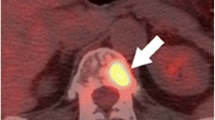Abstract
In the management of prostate cancer, combined anatomic and metabolic imaging is already in clinical use. In daily clinical practice, fusion of magnetic resonance imaging and magnetic resonance spectroscopic imaging is improving the evaluation of cancer location, size, and extent and is simultaneously providing assessment of tumor aggressiveness. Pretreatment knowledge of these prognostic variables is essential if minimally invasive, patient-specific cancer therapy is to be achieved. This report discusses the changes that are occurring in oncologic imaging and in genitourinary oncologic imaging in particular. It presents an overview of the applications of magnetic resonance imaging and magnetic resonance spectroscopic imaging for prostate cancer that is intended to illustrate the evolution of state-of-the-art imaging in a clinical setting. It also provides a short review of molecular imaging probes from the field of ongoing prostate cancer research. It concludes with a broader discussion of the nature of molecular imaging and the benefits it offers for cancer research and clinical care, which include noninvasive, in vivo imaging of specific cellular and molecular processes, nearly simultaneous monitoring of multiple molecular events, real-time imaging of the trafficking and targeting of cells, optimal patient-specific adjustment of drug and gene therapy, and assessment of disease progression at a molecular pathologic level.



Similar content being viewed by others
References
Ries LAG, Eisner MP, Kosary CL, et al, eds. SEER cancer statistics review, 1975–2001. Bethesda, MD: National Cancer Institute, 2004. Available at: http://www.seer.cancer.gov/csr/1975_2001/
Rendon RA, Stanietzky N, Panzarella T, et al. The natural history of small renal masses. J Urol 2000;164:1143–1147
Bretheau D, Lechevallier E, Eghazarian C, et al. Prognostic significance of incidental renal cell carcinoma. Eur Urol 1995;27:319–323
Wefer AE, Hricak H, Vigneron DB, et al. Sextant localization of prostate cancer: comparison of sextant biopsy, magnetic resonance imaging and magnetic resonance spectroscopic imaging with step section histology. J Urol 2000;164:400–404
Beyersdorff D, Taupitz M, Winkelmann B, et al. Patients with a history of elevated prostate-specific antigen levels and negative transrectal US-guided quadrant or sextant biopsy results: value of MR imaging. Radiology 2002;224:701–706
Scheidler J, Hricak H, Vigneron DB, et al. Prostate cancer: localization with three-dimensional proton MR spectroscopic imaging—clinicopathologic study. Radiology 1999;213:473–480
Terris MK. Prostate biopsy strategies: past, present, and future. Urol Clin North Am 2002;29:205–212
Steinberg DM, Sauvageot J, Piantadosi S, Epstein JI. Correlation of prostate needle biopsy and radical prostatectomy Gleason grade in academic and community settings. Am J Surg Pathol 1997;21:566–576
Zakian KL, Sircar K, Hricak H, et al. (2005) Correlation of proton MR spectroscopic imaging with gleason score based on step-section pathologic analysis after radical prostatectomy. Radiology 234:804–814
Wang L, Mullerad M, Chen HN, et al. Prostate cancer: incremental value of endorectal mr imaging findings for prediction of extracapsular extension. Radiology 2004;232:133–139
Yu KK, Scheidler J, Hricak H, et al. Prostate cancer: prediction of extracapsular extension with endorectal MR imaging and three-dimensional proton MR spectroscopic imaging. Radiology 1999;213:481–488
Hricak H, Wang L, Wei DC, et al. The role of preoperative endorectal magnetic resonance imaging in the decision regarding whether to preserve or resect neurovascular bundles during radical retropubic prostatectomy. Cancer 2004;100:2655–2663
Coakley FV, Eberhardt S, Wei DC, et al. Blood loss during radical retropubic prostatectomy: relationship to morphologic features on preoperative endorectal magnetic resonance imaging. Urology 2002;59:884–888
Coakley FV, Eberhardt S, Kattan MW, et al. Urinary continence after radical retropubic prostatectomy: relationship with membranous urethral length on preoperative endorectal magnetic resonance imaging. J Urol 2002;168:1032–1035
Bander NH, Nanus DM, Milowsky MI, et al. Targeted systemic therapy of prostate cancer with a monoclonal antibody to prostate-specific membrane antigen. Semin Oncol 2003;30:667
Heath JR, Phelps ME, Hood L. NanoSystems biology. Mol Imaging Biol 2003;5:312–325
Author information
Authors and Affiliations
Corresponding author
Additional information
An erratum to this article is available at http://dx.doi.org/10.1007/s00261-015-0414-z.
This review article has been retracted upon the request of the author as it contains similar text and illustrations to previously published articles. For further information, please contact the author Hedvig Hricak, MD at hricakh@mskcc.org
About this article
Cite this article
Hricak, H. RETRACTED ARTICLE: New horizons in genitourinary oncologic imaging. Abdom Imaging 31, 182–187 (2006). https://doi.org/10.1007/s00261-005-0385-6
Published:
Issue Date:
DOI: https://doi.org/10.1007/s00261-005-0385-6




